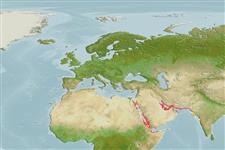>
Gobiiformes (Gobies) >
Gobiidae (Gobies) > Gobiinae
Etymology: Trimma: Greek, trimma, -atos = something crushed (Ref. 45335).
Eponymy: A Avidor was an ichthyologist at Tel Aviv University, Israel. He co-wrote: Biosociology and ecology of pomacentrid fishes around the Sinai Peninsula (northern Red Sea) (1974). He collected the type. (Ref. 128868), visit book page.
Environment: milieu / climate zone / ระดับความลึก / distribution range
นิเวศวิทยา
เกี่ยวกับทะเล,น้ำเค็ม เกี่ยวกับหินโสโครก; ระดับความลึก 0 - 6 m (Ref. 13694). Tropical
Western Indian Ocean: Gulf of Aqaba to the Gulf of Tadjoura, Djibouti in the Gulf of Aden.
ขนาด / น้ำหนัก / Age
วัยเจริญพันธุ์: Lm ? range ? - ? cm
Max length : 2.5 cm TL เพศผู้/กระเทย; (Ref. 11344); น้ำหนักสูงสุดที่มีการรายงาน: 0.18 g (Ref. 131019)
Life cycle and mating behavior
วัยเจริญพันธุ์ | การสืบพันธุ์ | การวางไข่ | เซลสืบพันธ์ของเพศเมีย(ไข่) | ความดกของไข่ | ตัวอ่อน
Winterbottom, R., 1995. Red Sea gobiid fishes of the genus Trimma, with the description of two new species. Rev. Fr. Aquariol. 22(3-4):93-98. (Ref. 13694)
IUCN Red List Status (Ref. 130435: Version 2024-2)
Threat to humans
Harmless
Human uses
การประมง: ไม่มีผลประโยชน์
เครื่องมือ
Special reports
Download XML
แหล่งที่มาจากอินเตอร์เน็ต
Estimates based on models
Preferred temperature (อ้างอิง
123201): 24.8 - 29.2, mean 27.9 °C (based on 278 cells).
Phylogenetic diversity index (อ้างอิง
82804): PD
50 = 0.5000 [Uniqueness, from 0.5 = low to 2.0 = high].
Bayesian length-weight: a=0.01023 (0.00559 - 0.01873), b=3.01 (2.85 - 3.17), in cm total length, based on LWR estimates for this species & (Sub)family-body (Ref.
93245).
ความสามารถในการกลับคืนสู่ปกติ (อ้างอิง
120179): ความสูง, เวลาต่ำสุดที่จะทำให้ประชากรเพิ่มขึ้นเป็น 2 เท่าใช้เวลาน้อยกว่า 15 เดือน (Preliminary K or Fecundity.).
Fishing Vulnerability (Ref.
59153): Low vulnerability (10 of 100).
🛈
